Fishing Rod Guides
"Sorta Like The Barrel Of A Gun"
A Critical and Delicate Rod Component
Fishing Rod Guides
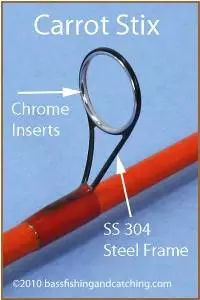
So what exactly do fishing rod guides contribute to the form and function of a bass rod? Those circular loops of metal that are affixed to the length of the rod?
First, they keep the line away from the rod and secondly they provide a smooth surface over which the line slides. "So what?" you ask. By keeping the line away from the rod the ability to cast is enhanced. By having a smooth surface within the ring over which the line can move friction is minimized. And we all know that friction creates heat and that heat is not your line's friend. Furthermore, your line takes less of a beating, suffers less wear and tear by passing over smooth surfaces.
Guides serve to direct your line to your target, like the barrel of a gun directs a bullet. Imagine fishing without guides on your rod. You're ability to reach most bass would be greatly diminished.
Guides also contribute to a rod's sensitivity and casting distance. Guides that are lightweight and high quality function very well in transmitting line vibrations to the rod and ultimately the anglers hands. Another factor in rod sensitivity is the number and location of guides on a rod.

Rod Guide Materials
Historically, guides were predominately steel and sometimes were coated with chrome. Then, in the 1960's, ceramic rings were inserted inside the rings. This eliminated the need to replace guides due to wear. It just didn't happen. However, these rings were heavy and prone to dropping their ceramic inserts if the rod was knocked around. This system has been greatly improved and metal guide rings have ceramic inserts that are fastened directly to them virtually eliminating any "drop-out".
There are numerous materials from which guides are made. A dissertation could be written (probably has) about fishing rod guides and the material from which they are made, focusing on hardness, weight, heat dissipation, durability and a multitude of other considerations. I'm just an old "peddler" (salesman) and avid bass fisherman. So all that matters to me, unlike rod manufacturers and custom rod builders, is the weight and durability of the guides on the rods I buy. So I'll not try to explain the physics and engineering of rod guides. It's beyond me.
However, it should be obvious that the heavier the guides, the number of guides and where they're placed on the rod's shaft will impact that rod's general responsiveness and sensitivity as well as its castability. Heat dissipation, while important when deep-sea fishing where there are often long runs by the fish and extreme friction generated, is not really an issue for us bass fishermen. What should be important to us is that the guides on the rods we buy are lightweight and durable and that there are the appropriate number on the rod and that they are properly placed.
So, as for materials, I'll just tell the following are the most common.
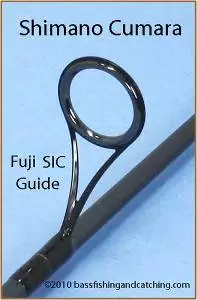
Silicone Carbide
So What Does SIC Mean? What are SIC Guides?
Today, Silicon carbide, referred to as SiC, and titanium carbide are considered the best materials for fishing rod guides. Friction and heat are reduced to a bare minimum with these advanced ceramic ring guides. Less friction translates into longer casts. Additionally, this material stands up to the new braids and superlines,. As guides with silicone carbide or titanium carbide are quite expensive you will find them only on your "high-end" brand name rods or your custom rods.
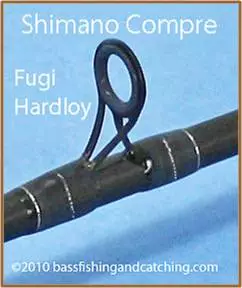
Aluminum Oxide
Alconite, Sounds Space Age
Alconite is a guide material whose base is aluminum oxide. It offers exceptional smoothness and durability but at a lower cost than silicon carbide. Fuji alconite guides were developed to be lighter than SIC, Hardloy or aluminum oxide. The surface is extremely smooth.
Hardloy
Hardloy is another grade of aluminum oxide, another ceramic material, from which fishing rod guides are made. it is not as expensive as the preceding materials but us quite durable. Fuji Hardloy guides are that company's most popular guide.
Aluminum Oxide
The ceramic material from which guides began to be made some 40+ years ago and from which many are made today.
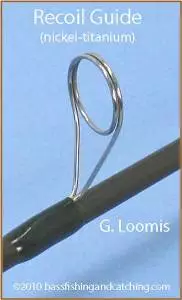
Titanium
Titanium used for fishing rod guides is a new and expensive development. A nice feature is its propensity to spring back to its original shape even if bent flat. RECOIL® guides from REC Components, found on high quality rods like G. Loomis, are made from nickle titanium alloy. This is a material which enables the guide to bend and spring back to its original shape. It is also 4 to 5 times lighter than similar guides. It is also highly resistant to corrosion. These guides do not have ceramic inserts. The metal is hard and flexible at the same time. How does that happen?
It should be pointed out that there are some rod makers, mainly custom rod builders, that are not particularly impressed with Recoil® guides. The complaint is that superlines cut grooves in the guides and can do so rapidly even for weekend anglers. This has certainly not been my experience. But I have a lot of respect for the guys whose skills enable them to make excellent custom rods and felt their opinion should be passed along.

I've included below a brief table showing you which guides are used by some rod manufacturers.
| Rod Companies | Rod Name | Guides Used |
|---|---|---|
| All Star | All Rods | Fuji Aluminum Oxide |
| e21 | Gold | TiCH |
| e21 | Carrot Stix | Steel, Chrome |
| Kistler | All rods | Fuji Ceramic (?) |
| Skeet Reese | All Rods | Zirconium |
| Quantum | Cumara | Fuji SIC |
| Quantum | Compre | Fuji Hardloy |
| Quantum | Crucial | Fuji Alconite |
| Falcon | Cara T7 | Fuji Alconite |
| Falcon | Low Rider | Fuji Aluminum Oxide |
| St, Croix | Premier Graphite | Fuji Aluminum Oxide |
| St. Croix | Mojo Bass | Batson Aluminum Oxide |
| St. Croix | Avid | Fuji Alconite |
| St. Croix | Tour Legend | Fuji Alconite |
| G.Loomis | GLX Bass | Recoil Titanium |
| G.Loomis | Mossyback Rods | AFTCO Alconite |
| G.Loomis | Smallmouth | Alconite |
| G.Loomis | Spinnerbait Rods | Alconite |
| G.Loomis | Drop Shot Rods | Alconite |
| Bass Pro | Bionic | Pacific Bay Hialoy |
| Bass Pro | Extreme | Pacific Bay Hialoy |
| Bass Pro | Jim Morris Signature | Fuji Titanium SIC |
Other Guide Considerations
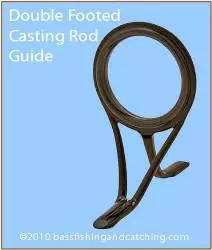 |
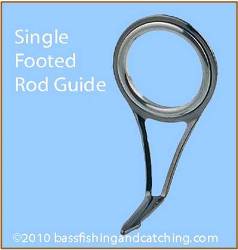 |
Style Of Guides
Fishing rod guides are produced in both double and single footed formats.
Single foot guides weigh less and are more sensitive. These guides are used most often on spinning rods. Though originally used on medium to light spinning rods technology has facilitated the construction of heavier duty spinning rods and correspondingly single foot guides to accommodate them.
Double footed fishing rod guides are for designed to provide more strength and tend to less sensitive. They're found on casting rods for bass and other rods manufactured for large game fish.
Number of Guides
A rod with more guides will generally cast better and be more responsive. Energy and stress are more evenly spread throughout the length of the rod. This makes for a more responsive rod and a rod that will withstand the pressures encountered while fighting a bass.
Generally speaking, there should be a guide for every foot of rod. A 6' rod should have six guides, possibly seven, plus a tip guide for example. Spacing between fishing rod guides is wider at the butt end with the distance reducing as they move closer to the tip. Lower quality rods will often be found to have too few guides. Be certain to count them and if there are fewer than one per foot of rod put the rod back on the rack. Also check the in-line placement to assure they are aligned correctly.

Innovation Marches On
The Newest Thing In Rod Guides - Micro Guides
In 2009 at ICAST the first production "micro guides" were introduced. Prior to this they were used exclusively by custom rod builders, at least in the U.S. These new guides were in sizes 2mm-5mm. To put this in perspective, production rods have an end guide with the measure of 6mm.
Allegedly these smaller fishing rod guides offer increased sensitivity due to the decreased weight of the guides themselves and the reduction in necessary thread wrap and finish lacquer. Less line "slap", when line bangs against the inside of the guide rings, results in greater casting distance and fewer wind knots. The one I like best is a reduction tangles from rods on deck or during transport. I like that one because I rarely have less than eight rods on deck.
As for negatives, they can clog with water-borne material like leaves, slime, grass etc. They can freeze over in temperatures under 32°. I'm not concerned about that one because if it's that cold I'll not be on the water. Don't know about you. Lines with memory like fluorocarbon or monofilament that have been on the reel for a while, can perform poorly as it won't pass through the rod eyes very easily.
Back To Bass Fishing Rods From Fishing Rod Guides
